On this page:
What is an activity centre structure?
Activity centres, although of different sizes and types, are a focus for:
- enterprise and social interaction
- incorporating community facilities and services
- shoppin
- employment and residences
Activity centres are the focus of public transport nodes where services converge. Activity centres include metropolitan centres, regional cities and town centres in rural areas.
An activity centre generally has an intense central core with smaller street blocks and a higher density of streets and lots. The structure of activity centres should allow for more intensive development, street frontage exposure for display, safe public spaces and pedestrian access to facilities.
Why is it important?
Activity centres provide residents, visitors and workers with easy access to a range of services and facilities as well as opportunities for establishing businesses, or simply being sociable and meeting others. By providing a variety of lot sizes and shapes in a connected movement network, an activity centre can accommodate a wide variety and scale of uses and buildings and respond to the changing needs of residents, businesses and visitors.
Some specialised and single-focus activity centres may have extended periods of inactivity with poor safety out-of-hours. Activity centres with a diverse mix of activities and uses adds to their vibrancy and economic viability as well as improving perceptions of safety and reducing opportunities for crime.
Objective 1.2.1: ensure accessible and functional activity centres
- Locate the activity centre where the main streets and public transport routes converge.
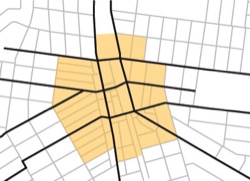
- Locate lots for medium and higher density residential and retirement housing within a five minute walk (400m) of an activity centre.
- Shape and orient blocks on the perimeter of the activity centre to support direct access to the activity centre core, from the surrounding neighbourhood.
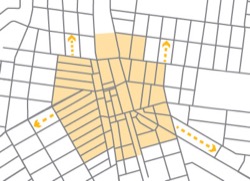
- In activity centres, provide a closely spaced and interconnected network of street and lanes.
Tip: Having more streets allows people a choice of routes, and can disperse the volume of pedestrian and vehicle traffic across a number of routes. In areas of intense activity, more streets can also provide increased frontage length.
- Provide rear or side lane vehicle access to lots within activity centres.
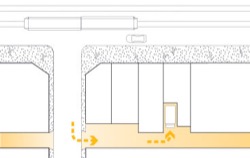
Tip: By providing rear or side lane access for vehicle, service and delivery functions, street frontages can remain safe and active, uninterrupted by vehicle crossovers. - Create a range of lot sizes for intense uses at the activity centre core.
Tip: The core of the activity centre is the best connected location; the functional centre may not be the geographical centre point. The core is often where the main streets connect.
Objective 1.2.2: ensure activity centre structure supports public transport access
- Provide for train stations and public transport interchanges within the core of activity centre.
Tip: While frequent bus movements on pedestrian priority streets are not desired, an interchange crossing the main street at one end may be a convenient, accessible option.
- On streets within activity centres that accommodate public transport services, minimise intersections and vehicle access points to lots.
Tip: Private vehicles entering or turning out of a street that accommodates on-road public transport, can cause service delays. See Guideline sources and references for link to Public Transport Guidelines.
- Provide for priority or separated lanes for public transport on roads where multiple public transport routes converge within activity centres.
Objective 1.2.3: ensure the activity centre structure supports safety and amenity
- Locate lots intended for retail and commercial uses on well- connected main streets in activity centres.
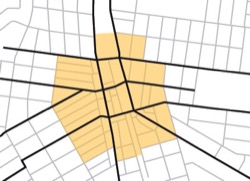
Tip: intense and diverse commercial activities on smaller lots with narrower frontages, or mixed uses with multiple tenancies, contribute to an active and interesting public realm. - Locate lots for active uses and uses with long operating hours on pedestrian priority streets.
Tip: personal safety is best achieved by having people present on the street during the day and at night, and by providing opportunities for informal surveillance of public spaces.
- Provide lots for shops on streets that allow zero street setbacks and continuous built frontages.
Tip: retail activities in buildings function best when they have direct access abutting the footpath and when supported by similar neighbours.
- Surround the activity centre core with lots that are large enough to accommodate higher density residential uses and workplaces. Tip: small, narrow lots are difficult to develop at higher densities.
- Locate large public facilities, such as hospitals, schools, and major recreation facilities on public transport routes and at the edge of activity centres.
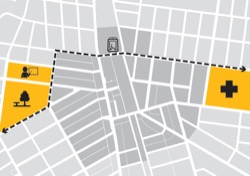
Tip: facilities that occupy large land areas can create a barrier to movement through an activity centre. Out of operating hours, the facilities may present an inactive edge to streets and paths. - Locate lots for large format uses that generate high vehicle traffic volumes on wider streets at the edge of activity centres, and with easy access to major roads.
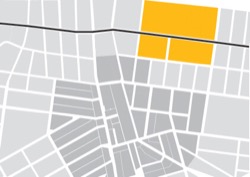
Objective 1.2.4: activate the activity centre's interface with its barrier edges
Typical barriers or edges to an activity centre are railway or motorway corridors, a water body or a natural feature.
- Where an activity centre has a barrier or edge, provide an active public space or a street between the edge and the adjacent buildings.
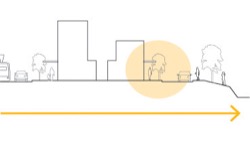
Tip: Where a barrier or edge has few passing pedestrians or little activity in the adjacent buildings (e.g. has a rear boundary toward the edge), public spaces in these areas may attract fewer visitors and be a security risk.
Objective 1.2.5 respond to change within an activity centre.
As an activity centre evolves and changes, its structure may need review to provide new connections, changes in land use patterns or the re-allocation of public space for different activities. Structure planning can assist in managing this change.
- Create a regular block and lot pattern within the activity centre that enables future lot subdivision or consolidation.
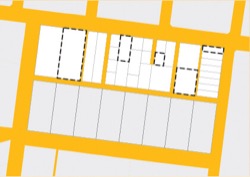
Tip: Irregular shaped lots can limit future lot subdivision or consolidation. - Where activity centres experience increased residential densities or an expanding worker population, maintain or increase the capacity of the pedestrian movement network by adding new mid-block links and public spaces.
Tip: Periodic reviews of the functionality and safety of the public realm in an activity centre, may indicate need for adjustment to its structure.
- As an activity centre evolves and intensifies, allow future development to front laneways.
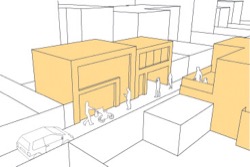
- When consolidating or subdividing lots, maintain a fine- grained street frontage.
Tip: Fine-grained street frontages have multiple shopfronts with doorways and windows.
Page last updated: 28/10/25